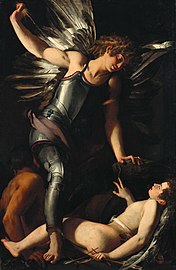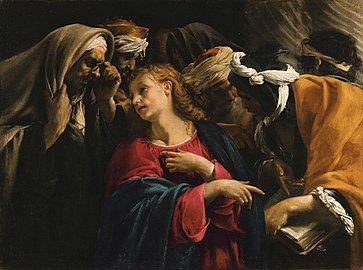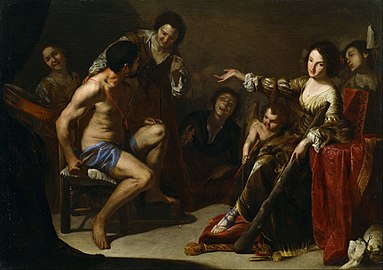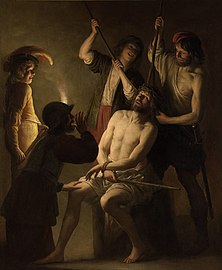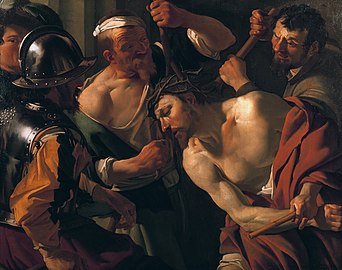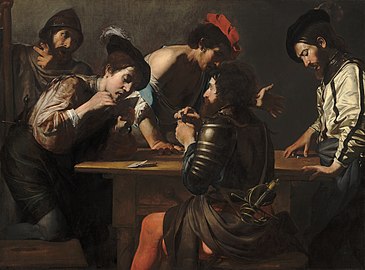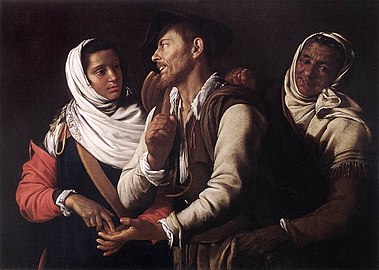
Michelangelo Merisi da Caravaggio, known mononymously as Caravaggio, was an Italian painter active in Rome for most of his artistic life. During the final four years of his life, he moved between Naples, Malta, and Sicily until his death. His paintings have been characterized by art critics as combining a realistic observation of the human state, both physical and emotional, with a dramatic use of lighting, which had a formative influence on Baroque painting.

Bernardo Strozzi, named il Cappuccino and il Prete Genovese, was an Italian Baroque painter and engraver. A canvas and fresco artist, his wide subject range included history, allegorical, genre and portrait paintings as well as still lifes. Born and initially mainly active in Genoa, he worked in Venice in the latter part of his career. His work exercised considerable influence on artistic developments in both cities. He is considered a principal founder of the Venetian Baroque style. His powerful art stands out by its rich and glowing colour and broad, energetic brushstrokes.

Utrecht Caravaggism refers to the work of a group of artists who were from, or had studied in, the Dutch city of Utrecht, and during their stay in Rome during the early seventeenth century had become distinctly influenced by the art of Caravaggio. Upon their return to the Dutch Republic, they worked in a so-called Caravaggist style, which in turn influenced an earlier generation of local artists as well as artists in Flanders. The key figures in the movement were Hendrick ter Brugghen, Gerrit van Honthorst and Dirck van Baburen, who introduced Caravaggism into Utrecht painting around 1620. After 1630 the artists moved in other directions and the movement petered out. The Utrecht Caravaggisti painted predominantly history scenes and genre scenes executed in a realist style.

Cecco del Caravaggio is the Notname given to a painter who worked in Rome in the early decades of the 17th century and was an important early follower of Caravaggio (1571–1610). In the past art historians have suggested he may have been a Flemish, French or Spanish Caravaggist but more recently some have identified the artist with Francesco Boneri, although this is not universally accepted. In his work the artist responded in a very individual and original manner to Caravaggio's naturalism.

Giovanni Battista Caracciolo (1578–1635) was an Italian artist and important Neapolitan follower of Caravaggio. He was a member of the murderous Cabal of Naples, with Belisario Corenzio and Giambattista Caracciolo, who were rumoured to have poisoned and disappeared their competition for painting contracts.

Bartolomeo Manfredi was an Italian painter, a leading member of the Caravaggisti of the early 17th century.
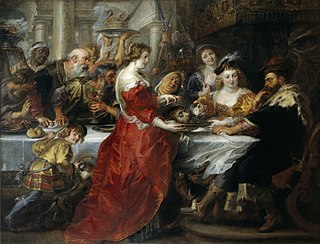
Gaspar Roomer was a Flemish merchant, banker, art patron and art collector who was active in Naples in the 17th century. He played an important role in the support and promotion of Flemish artists who visited and worked in Naples.

Massimo Stanzione was an Italian Baroque painter, mainly active in Naples, where he and his rival Jusepe de Ribera dominated the painting scene for several decades. He was primarily a painter of altarpieces, working in both oils and fresco. His main subject matter was biblical scenes. He also painted portraits and mythological subjects. He had many pupils and followers as his rich color and idealized naturalism had a large influence on other local artists, such as Francesco Solimena. In 1621 Pope Gregory XV gave him the title of Knight of the Golden Spur and Pope Urban VIII made him a knight of St. John around 1624 and a knight of the Order of Christ in 1627. From then on, he liked to sign his works as "EQUES MAXIMUS".

Nicolas Régnier (1591–1667), known in Italy as Niccolò Renieri, was a painter, art dealer and art collector from the County of Hainaut, a French-speaking part of the Spanish Netherlands. He is often referred to as a Flemish artist because this term was often used to designate people from the Spanish Netherlands. After training in Antwerp, he was active in Italy where he was part of the international Caravaggesque movement. His subjects include genre scenes with card players, fortune tellers, soldiers and concerts, religious scenes, saints, mythological and allegorical scenes, and portraits. He also painted a few scenes with carnivals.

Orazio Riminaldi was an Italian painter who painted mainly history subjects in a Caravaggist style.

Theodoor Rombouts was a Flemish painter who is mainly known for his Caravaggesque genre scenes depicting lively dramatic gatherings as well as religiously-themed works. He is considered to be the primary and most original representative of Flemish Caravaggism. These Caravaggisti were part of an international movement of European artists who interpreted the work of Caravaggio and the followers of Caravaggio in a personal manner.

Bartolomeo Cavarozzi (1587–1625), occasionally referred to as Bartolomeo Crescenzi, was an Italian caravaggisti painter of the Baroque period. Cavarozzi's work began receiving increased admiration and appreciation from art historians in the last few decades of the 20th century, emerging as one of the more distinct and original followers of Caravaggio. He received training from Giovanni Battista Crescenzi in Rome and later traveled to Spain alongside his master for a few years where he achieved some renown and was significant in spreading "Caravaggism" to Spain before returning to Italy. His surviving works are predominantly Biblical subjects and still-life paintings, although older references note he "was esteemed a good painter especially of portraits".

Flemish Baroque painting was a style of painting in the Southern Netherlands during Spanish control in the 16th and 17th centuries. The period roughly begins when the Dutch Republic was split from the Habsburg Spain regions to the south with the Spanish recapturing of Antwerp in 1585 and goes until about 1700, when Spanish Habsburg authority ended with the death of King Charles II. Antwerp, home to the prominent artists Peter Paul Rubens, Anthony van Dyck, and Jacob Jordaens, was the artistic nexus, while other notable cities include Brussels and Ghent.

Gerard Seghers was a Flemish painter, art collector, and art dealer. After a period of study and residence in Italy, he returned to Flanders where he became one of the leading representatives of the Flemish Caravaggisti movement. In his later career he abandoned the Caravaggist style and genre motifs to become an important painter of large altarpieces for local churches.
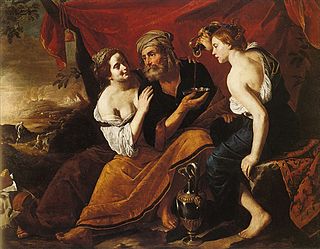
Hendrick de Somer (1602–c.1655) was a Flemish painter who spent most of his life and career in Italy. He was mainly active in Naples.

Matthias Stom or Matthias Stomer was a Dutch, or possibly Flemish, painter who is only known for the works he produced during his residence in Italy. He was influenced by the work of non-Italian followers of Caravaggio in Italy, in particular his Dutch followers often referred to as the Utrecht Caravaggists, as well as by Jusepe de Ribera and Peter Paul Rubens. He did not share the other Northern Caravaggisti's preference for humorous, and sometimes scabrous, genre scenes and elaborate decorative allegories but favored stories from the bible instead. He worked in various locations in Italy where he enjoyed the patronage of religious institutions as well as prominent members of the nobility.

Jean Ducamps, Giovanni di Filippo del Campo or Giovanni del Campo, was a Flemish Baroque painter who spent most of his career in Italy where he enjoyed notoriety for his religious compositions, genre scenes and allegories. He worked in a style that was influenced by Caravaggio and is counted amongst the Northern Caravaggisti.

Jan Janssens was a Flemish Baroque painter and draftsman who is considered to be the most important of the so-called Ghent Caravaggisti. These Caravaggisti were part of an international movement of European artists who interpreted the work of Caravaggio and the followers of Caravaggio in a personal manner. Janssens altarpieces and other compositions offering very realistic representations of religious motifs adorn many churches in and around Ghent. He also worked on commissions for international patrons.

The Master of the Gamblers is the notname given to a painter active in Rome and possibly also in Naples in the second and third decade of the 17th century, whose subject matter and style rank him among the Caravaggisti. The artist depicted genre subjects and still life elements in his works in a stark naturalist manner. The identity and nationality of the artist are not known. Art historians have yet to arrive at a unanimous view on the nationality, work location and the oeuvre of the artist. He may have been Italian, but a northern European background has also been proposed.
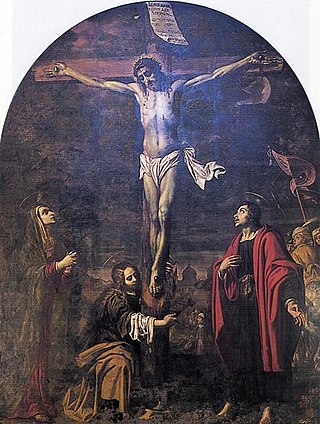
Joannes, Jan or Giovannivan Houbraken, van Houbracken or Houbraken was a Flemish painter and art dealer. He painted religious compositions and allegorical genre scenes. He lived and worked for a while in Italy, first in Rome, later in Naples and finally in Messina. He became familiar with the work of the Caravaggisti, whose style influenced him. After his return to Antwerp he engaged in trade with Italy and sent his works and other items produced by Antwerp craftsmen to patrons in Italy.

